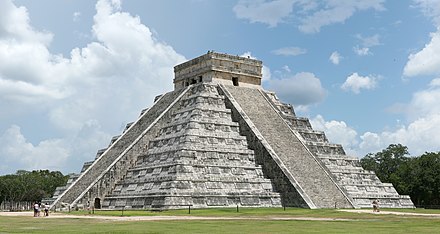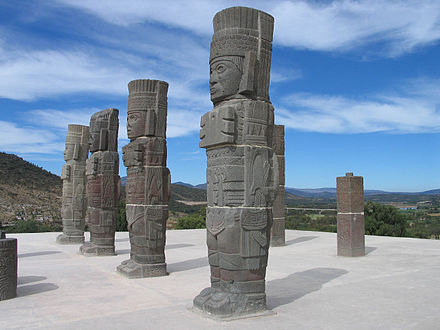
The history of Mexico spans more than three millennia, beginning with the early settlement over 13,000 years ago. Central and southern Mexico, known as Mesoamerica, saw the rise of complex civilizations that developed glyphic writing systems, recording political histories and conquests. The Spanish conquest of the Aztec Empire in the early 16th century established New Spain, bringing Spanish rule, Christianity, and European influences.
Mexico gained independence from Spain in 1821, after a prolonged struggle marked by the Mexican War of Independence. The country faced numerous challenges in the 19th century, including regional conflicts, caudillo power struggles, the Mexican–American War, and foreign interventions like the French invasion. Efforts at modernization during La Reforma included promoting civil liberties and the separation of church and state, but the country was still beset by internal strife and external threats, including the Second Mexican Empire.
The late 19th-century Porfiriato era brought economic growth but also authoritarianism and social inequality, which eventually fueled the Mexican Revolution in 1910. The revolution led to significant social and political changes, with the emergence of the Institutional Revolutionary Party (PRI) as the dominant force. Throughout the 20th century, Mexico implemented land reforms, nationalized key industries, and expanded social welfare, but these achievements were marred by corruption, violence, and economic crises.
In the 1980s and 1990s, Mexico shifted towards privatization and trade liberalization, culminating in the signing of the North American Free Trade Agreement (NAFTA) in 1994. The turn of the century marked a significant shift in Mexico's political landscape, with the opposition National Action Party (PAN) winning the presidency in 2000, ending the PRI's long-standing dominance and ushering in a new era of Mexican politics. The 21st century has seen economic disparities, drug-related violence, and corruption. Administrations have focused on addressing these issues, with mixed success. The election of Andrés Manuel López Obrador in 2018 marked another significant shift, as his government has aimed to combat corruption, reduce inequality, and address the violence that has plagued the country for decades.


Large and complex civilizations developed in the center and southern regions of Mexico (with the southern region extending into what is now Central America) in what has come to be known as Mesoamerica. The civilizations that rose and declined over millennia were characterized by:[1]
The history of Mexico before the Spanish conquest is known through the work of archaeologists, epigraphers, and ethnohistorians, who analyze Mesoamerican indigenous manuscripts, particularly Aztec codices, Mayan codices, and Mixtec codices. Accounts written by Spaniards at the time of the conquest (the conquistadores) and by Indigenous chroniclers of the postconquest period constitute the principal source of information regarding Mexico at the time of the Spanish Conquest. Few pictorial manuscripts (or codices) of the Maya, Mixtec, and Mexica cultures of the Post-Classic period survive, but progress has been made particularly in the area of Maya archaeology and epigraphy.[2]

The presence of people in Mesoamerica was once thought to date back 40,000 years, an estimate based on what were believed to be ancient footprints discovered in the Valley of Mexico. This date may not be accurate after further investigation using radiocarbon dating.[3] It is currently unclear whether 23,000-year-old campfire remains found in the Valley of Mexico are the earliest human remains uncovered so far in Mexico.[4]The first people to settle in Mexico encountered a climate far milder than the current one. In particular, the Valley of Mexico contained several large paleo-lakes (known collectively as Lake Texcoco) surrounded by dense forest. Deer were found in this area, but most fauna were small land animals and fish and other lacustrine animals were found in the lake region.[5] Such conditions encouraged the initial pursuit of a hunter-gatherer existence. Indigenous peoples in western Mexico began to selectively breed maize (Zea mays) plants between 5,000 and 10,000 years ago.[6] The diet of ancient central and southern Mexico was varied, including domesticated corn (or maize), squashes, beans, tomatoes, peppers, cassavas, pineapples, chocolate, and tobacco. The Three Sisters (corn, squash, and beans) constituted the principal diet.[7]

Mesoamericans had belief systems where every element of the cosmos and everything that forms part of nature represented a supernatural manifestation. The spiritual pantheon was vast and extremely complex. They frequently took on different characteristics and even names in other areas, but in effect, they transcended cultures and time. Great masks with gaping jaws and monstrous features in stone or stucco were often located at the entrance to temples, symbolizing a cavern or cave on the flanks of the mountains that allowed access to the depths of Mother Earth and the shadowy roads that lead to the underworld.[8] Cults connected with the jaguar and jade especially permeated religion throughout Mesoamerica. Jade, with its translucent green color, was revered along with water as a symbol of life and fertility. The jaguar, agile, powerful, and fast, was especially connected with warriors and as spirit guides of shamans. Despite differences in chronology or geography, the crucial aspects of this religious pantheon were shared amongst the people of ancient Mesoamerica.[8] Thus, this quality of acceptance of new gods to the collection of existing gods may have been one of the shaping characteristics for success during the Christianization of Mesoamerica. New gods did not at once replace the old; they initially joined the ever-growing family of deities or were merged with existing ones that seemed to share similar characteristics or responsibilities.[8]
Mesoamerica is the only place in the Americas where Indigenous writing systems were invented and used before European colonization. While the types of writing systems in Mesoamerica range from minimalist "picture-writing" to complex logophonetic systems capable of recording speech and literature, they all share some core features that make them visually and functionally distinct from other writing systems of the world.[9] Although many indigenous manuscripts have been lost or destroyed, texts known as Aztec codices, Mayan codices, and Mixtec codices still survive and are of intense interest to scholars.

During the pre-Columbian period, many city-states, kingdoms, and empires competed with one another for power and prestige. Ancient Mexico can be said to have produced five major civilizations: the Olmec, Maya, Teotihuacan, Toltec, and Aztec. Unlike other indigenous Mexican societies, these civilizations (except the politically fragmented Maya) extended their political and cultural reach across Mexico and beyond.
They consolidated power and exercised influence in trade, art, politics, technology, and religion. Over 3,000 years, other regional powers made economic and political alliances with them; many made war on them. But almost all found themselves within their spheres of influence.
The Olmec first appeared along the Atlantic coast (in what is now the state of Tabasco) in the period 1500–900 BCE. The Olmecs were the first Mesoamerican culture to produce an identifiable artistic and cultural style and may also have been the society that invented writing in Mesoamerica. By the Middle Preclassic Period (900–300 BCE), Olmec artistic styles had been adopted as far away as the Valley of Mexico and Costa Rica.

Maya cultural characteristics, such as the rise of the ahau, or king, can be traced from 300 BCE onward. During the centuries preceding the classical period, Maya kingdoms stretched from the Pacific coasts of southern Mexico and Guatemala to the northern Yucatán Peninsula. The egalitarian Maya society of pre-royal centuries gradually led to a society controlled by a wealthy elite that began building large ceremonial temples and complexes. The earliest known long-count date, 199 AD, heralds the classic period, during which the Maya kingdoms supported a population numbering in the millions. Tikal, the largest of the kingdoms, alone had 500,000 inhabitants, though the average population of a kingdom was much smaller—somewhere under 50,000 people.

Teotihuacan is an enormous archaeological site in the Basin of Mexico, containing some of the largest pyramidal structures built in the pre-Columbian Americas. Apart from the pyramidal structures, Teotihuacan is also known for its large residential complexes, the Avenue of the Dead, and numerous colorful, well-preserved murals. Additionally, Teotihuacan produced a thin orange pottery style that spread through Mesoamerica.[10]

The city is thought to have been established around 100 BCE and continued to be built until about 250 CE.[11] The city may have lasted until sometime between the 7th and 8th centuries CE. At its zenith, perhaps in the first half of the 1st millennium CE, Teotihuacan was the largest city in the pre-Columbian Americas. At this time, it may have had more than 200,000 inhabitants, placing it among the world's largest cities in this period. Teotihuacan was even home to multi-floor apartment compounds built to accommodate this large population.[11]
The civilization and cultural complex associated with the site is also referred to as Teotihuacan or Teotihuacano. Although it is a subject of debate whether Teotihuacan was the center of a state empire, its influence throughout Mesoamerica is well documented. The ethnicity of the inhabitants of Teotihuacan is also a subject of debate. Possible candidates are the Nahua, Otomi or Totonac ethnic groups. Scholars have also suggested that Teotihuacan was a multiethnic state.

The Toltec culture is an archaeological Mesoamerican culture that dominated a state centered in Tula, Hidalgo, in the early post-classic period of Me